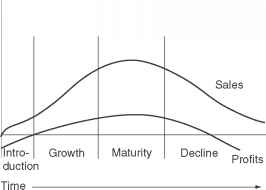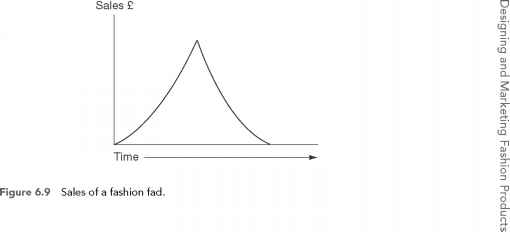The fashion product life cycle
The concept of the product life cycle is based on the proposal that all products have a finite 'life cycle' that can be plotted over a given period using the biological analogy of growth, development and decline. It proposes that all products will go through four major stages, namely introduction into the marketplace, growth, maturity and decline. However, it has already been pointed out that the nature of products in the fashion industry varies according to the rate, extent and timescale of acceptance of any new offering. Thus while fashion and fads do make up successful new product introductions, garments that are more classic in nature will never actually go 'out of fashion', nor will they rarely be 'in fashion', rather they will continue to meet established target market requirements. Thus the concept should be modified when analysing various fashion product classifications.
The life cycle of a fashion garment, extending over one or several seasons, probably comes nearest to the bell-shaped curve normally used to depict the product life cycle model (Figure 6.8).
The sales and profitability patterns and marketing implications of the model are described below.
Introduction
New fashions take time to gain acceptance. Some consumers will be more innovative than the majority and, while they are willing to pay higher prices, unit costs could potentially still be high due to low sales. However, to counterbalance this, the high fashion element (and therefore exclusive nature) of the style at this stage may mean that customers are willing to pay very high prices, leading to generation of high profits. Selected promotion will emphasize image and high fashion nature; the main aim will be to educate and inform the customer as quickly as possible. The size of the market will, however, be limited. Distribution will tend to remain exclusive.
Sales and profit £
Sales and profit £

- Figure 6.8 The fashion product life cycle.
Growth
Competition increases as the fashion gains exposure and begins to have wider appeal. Products will be modified to reduce costs and be offered at lower price levels. Sales will begin to rise sharply; new price bands will be established quite quickly. Distribution, still selective at this stage, will be wider as the fashion is diffused. Promotional emphasis will be on broadening exposure to gain acceptance of the fashion by the opinion forming element of the mass market.
Maturity
At this stage the fashion will have mass appeal; this period will be the longest in its life cycle. Competition will be intense, and prices will begin to fall to appeal to a very large market. Products will be further modified to achieve the ensuing lower price levels and profit potential will be falling. Distribution will be wide; promotional emphasis will be on reinforcement of what has by now become an established fashion.
Decline
The style is rapidly going out of fashion. Competitors are gradually eliminated as sales and profits are falling drastically and the prospect of being left with obsolete stock is near. Those left in the market may try to extend the product's life by intensive advertising, extending distribution or searching for new segments. The alternative segments are likely to balance concerns about the likely success of the

product against others such as price levels and the remaining life of the product.
Was this article helpful?
Readers' Questions
-
james boyle10 months ago
- Reply
-
Vicky Scott1 year ago
- Reply
-
aapo1 year ago
- Reply
-
wilson1 year ago
- Reply